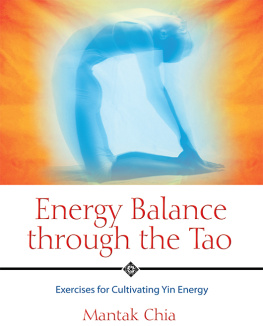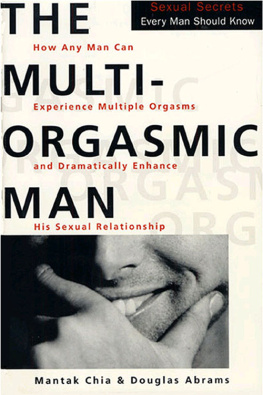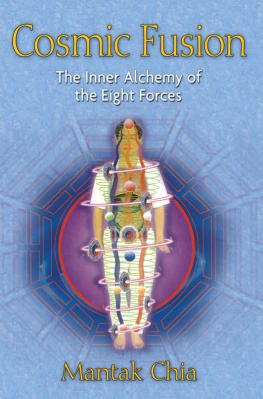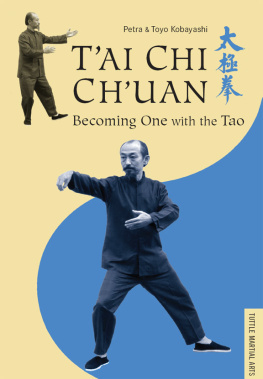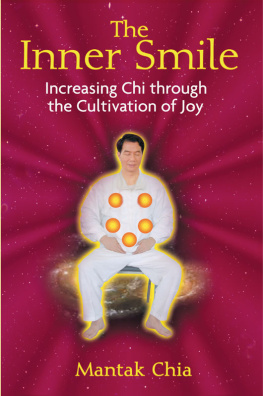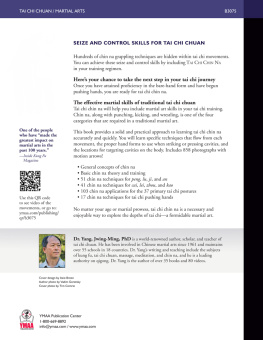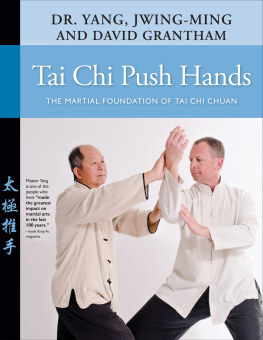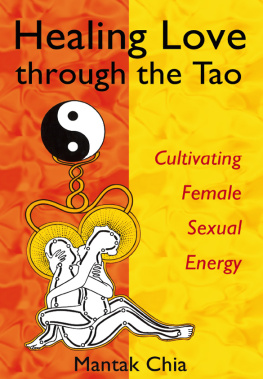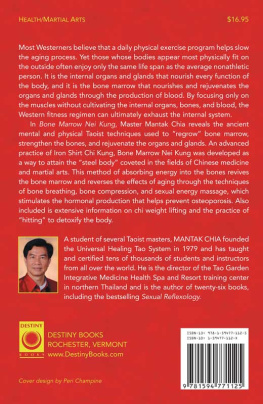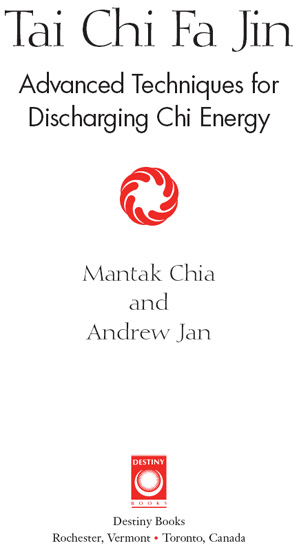

Dedicated to Tai Chi practitioners everywhere
Acknowledgments
The Universal Tao publications staff involved in the preparation and production of Tai Chi Fa Jin extend our gratitude to the many generations of Taoist Masters who have passed on their special lineage, in the form of an unbroken oral transmission, over thousands of years. We thank Taoist Master I Yun (Yi Eng) for his openness in transmitting the formulas of Taoist Inner Alchemy. We also wish to thank the thousands of unknown men and women of the Chinese healing arts who developed many of the methods and ideas presented in this book.
We offer our eternal gratitude to our parents and teachers for their many gifts to us. Remembering them brings joy and satisfaction to our continued efforts in presenting the Universal Healing Tao system. For their gifts, we offer our eternal gratitude and love. As always, their contribution has been crucial in presenting the concepts and techniques of the Universal Healing Tao.
Thanks to Juan Li for the use of his beautiful and visionary paintings, illustrating Taoist esoteric practices.
We thank the many contributors essential to this books final form: The editorial and production staff at Inner Traditions/Destiny Books for their efforts to clarify the text and produce a handsome new edition of the book and Gail Rex for her line edit of the new edition.
We wish to thank the following people for their assistance in producing the earlier editions of this book: Bob Zuraw for sharing his kindness, healing techniques, and Taoist understandings; Matthew Koren for his editorial work and writing contributions; Otto Thamboon for his artisic contributions to the revised edition of the book; our senior instructors, Wilbert Wils and Saumya Wils, for their insightful contributions to the revised edition; and Charles Morris, without whom the book would not have come to be, for inspiring and reorganizing the book.
A special thanks goes to our Thai production team: Hirunyathorn Punsan, Saysunee Yongyod, Udon Jandee, and Saniem Chaisam.
Putting Tai Chi Fa Jin into Practice
The practices described in this book have been used successfully for thousands of years by Taoists trained by personal instruction. Readers should not undertake the practice without receiving personal transmission and training from a certified instructor of the Universal Healing Tao, since certain of these practices, if done improperly, may cause injury or result in health problems. This book is intended to supplement individual training by the Universal Healing Tao and to serve as a reference guide for these practices. Anyone who undertakes these practices on the basis of this book alone does so entirely at his or her own risk.
The meditations, practices, and techniques described herein are not intended to be used as an alternative to or substitute for professional medical treatment and care. If any readers are suffering from illnesses based on mental or emotional disorders, an appropriate professional health care practitioner or therapist should be consulted. Such problems should be corrected before you start training.
Neither the Universal Healing Tao nor its staff and instructors can be responsible for the consequences of any practice or misuse of the information contained in this book. If the reader undertakes any exercise without strictly following the instructions, notes, and warnings, the responsibility must lie solely with the reader.
This book does not attempt to give any medical diagnosis, treatment, prescription, or remedial recommendation in relation to any human disease, ailment, suffering, or physical condition whatsoever.
Preface
The purpose of this book is to outline the study of discharge power, or Fa Jin, through the principles and teachings of the Universal Healing Tao system. In particular, this book draws on the practices of Iron Shirt, Tai Chi, Tan Tien Chi Kung, and meditation.
Teachings from the internal martial art classics and from current masters of these disciplines provide us with clues about the methodology employed in discharge power. However, internal arts are always difficult to describe because they are, by nature, internal and subjective. Descriptions of chi, mind, and specific visualizations vary from master to master within a discipline as well as between different traditions. These variations occur even when the masters are performing essentially similar tasks. Perhaps there are multiple internal methods that achieve the same discharge power. Alternatively, a master may be unable to describe in words the internal happenings that occur with the release of power, or unwilling to reveal too much about this esoteric art. In former years, masters would teach such techniques only to a small number of select students. Consequently, the art of Fa Jin is on the decrease.
To further complicate matters, variations of Fa Jin exist. They range from Bruce Lees one-inch punch to throwing an opponent in the air to transmitting an electric shock or intense heat. Despite these constraints, this book will nevertheless attempt to outline the methodology of Fa Jin and share this knowledge with all. By building upon the principles of Iron Shirt Chi Kung, the foundational form of Tai Chi Chi Kung, Tan Tien Chi Kung, the Fusion practices, and Kan and Li practice, we hope to arrange the information in a succinct and understandable way.
This book endeavors to create an original view of Fa Jin by blending the Universal Healing Tao internal training with the yang Tai Chi classics and teachings from present-day masters. The power generated by this blend of insight is practiced in the Tai Chi Chi Kung Discharge Form, which demonstrates five of the eight gates that can express discharge power. Another practice for cultivating discharge power that uses all eight gates is Push Hands. As a part of its discussion of discharge power, this book provides an overview of Push Hands routines and principles.
Many Tai Chi classics are now available in English thanks to authors such as Yang Jwing-Ming, Benjamin Lo, Barbara Davis, and Douglas Wile. This book will make direct references to available English translations of the works of Yang Lu-Chan, Wu Yu-Hsiang, Wu Cheng-Ching, and Li I-Yu. (Please note that spelling in some of the quotations that retain pinyin is altered slightly to maintain consistency with the authors.) The next book in this series will explore the Wu style, focusing on the works of Wu Quan-Yu.
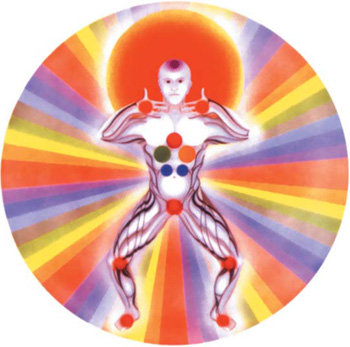
Iron Shirt Chi Kung
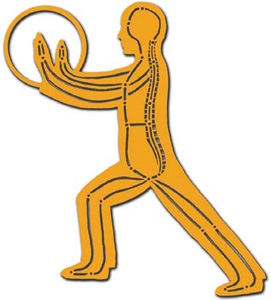
The foundational Tai Chi Chi Kung form
However, translation of historical Tai Chi texts is difficult because there are multiple meanings for many of the original characters. Accurate translation requires an appropriate depth of understanding of Tai Chi principles in order to extract the inner meaning. In other words, the depth of translation can be only as deep as the translators current mindset. Furthermore, understanding of the principles of Fa Jin can only occur when the student is ready to comprehend. Much of that understanding will come through meditation and the domain of martial interaction that allows hidden forces to materialize in the physical realm.
This book focuses on the reader who has an interest in both Taoist mystical practices and martial practice. It will suit the accomplished Tai Chi practitioner who seeks a deeper understanding of the energetic aspects of Fa Jin training, as well as the practitioner who has made some accomplishment with meditation and seeks a deeper understanding of the physical and martial domains. The book will be invaluable not only to students of the Universal Healing Tao system, but also to Tai Chi and meditation students of other schools who are searching for a fresh approach to this internal art or wishing to broaden their knowledge.
Next page

